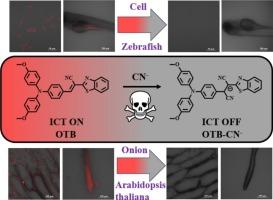Development of near-infrared fluorescent probes with AIE properties and their application in the detection and imaging of CN− in environmental water samples and multiple species (zebrafish/cells/plants)
IF 4.6
2区 化学
Q1 SPECTROSCOPY
Spectrochimica Acta Part A: Molecular and Biomolecular Spectroscopy
Pub Date : 2025-09-26
DOI:10.1016/j.saa.2025.127000
引用次数: 0
Abstract
Cyanide ions (CN−) are highly toxic pollutants that are widely present in industrial wastewater and the environment, posing a serious threat to ecosystems and human health. The development of highly sensitive and selective CN− detection technologies is an urgent need in environmental monitoring and biomedical fields. In this study, we designed and synthesized a near-infrared fluorescent probe, OTB, based on the aggregation-induced emission (AIE) mechanism. It features a methoxy-modified triphenylamine as the fluorescent moiety and incorporates a benzothiazole structure, achieving an ultra-large Stokes shift of 174 nm and near-infrared emission at 640 nm. The OTB probe achieves fluorescence quenching by CN− mediated affinity addition that disrupts the conjugated structure, with a detection limit as low as 0.451 μM for CN−. It also exhibits excellent interference resistance and broad pH stability. This probe has been successfully applied for the quantitative analysis of CN− in various environmental water samples such as tap water and lake water (recovery rate 94 %–110 %) and has achieved fluorescence imaging of CN− in multi-species biological samples including 4T1 cells, zebrafish, and Arabidopsis. This study provides a new technical approach for the efficient detection of cyanide, promoting the cross-application of hazardous substance detection in environmental and biomedical fields. This study proposes a new and efficient method for detecting CN−, promoting the application of hazardous substance detection technology in fields such as the environment and biomedicine.

具有AIE特性的近红外荧光探针的研制及其在环境水样和多物种(斑马鱼/细胞/植物)中CN-检测和成像中的应用
氰化物离子(CN-)是广泛存在于工业废水和环境中的剧毒污染物,对生态系统和人类健康构成严重威胁。发展高灵敏度、高选择性的CN-检测技术是环境监测和生物医学领域的迫切需要。在这项研究中,我们设计并合成了一种基于聚集诱导发射(AIE)机制的近红外荧光探针OTB。它以甲氧基修饰的三苯胺作为荧光部分,并结合了苯并噻唑结构,实现了174 nm的超大斯托克斯位移和640 nm的近红外发射。OTB探针通过CN-介导的亲和加成破坏共轭结构实现荧光猝灭,对CN-的检出限低至0.451 μM。它还具有优异的抗干扰性和广泛的pH稳定性。该探针已成功应用于自来水、湖水等多种环境水样中CN-的定量分析(回收率为94% ~ 110%),并在4T1细胞、斑马鱼、拟南芥等多物种生物样品中实现了CN-的荧光成像。本研究为氰化物的高效检测提供了新的技术途径,促进了有害物质检测在环境和生物医学领域的交叉应用。本研究提出了一种新的、高效的检测CN-的方法,促进了有害物质检测技术在环境、生物医学等领域的应用。
本文章由计算机程序翻译,如有差异,请以英文原文为准。
求助全文
约1分钟内获得全文
求助全文
来源期刊
CiteScore
8.40
自引率
11.40%
发文量
1364
审稿时长
40 days
期刊介绍:
Spectrochimica Acta, Part A: Molecular and Biomolecular Spectroscopy (SAA) is an interdisciplinary journal which spans from basic to applied aspects of optical spectroscopy in chemistry, medicine, biology, and materials science.
The journal publishes original scientific papers that feature high-quality spectroscopic data and analysis. From the broad range of optical spectroscopies, the emphasis is on electronic, vibrational or rotational spectra of molecules, rather than on spectroscopy based on magnetic moments.
Criteria for publication in SAA are novelty, uniqueness, and outstanding quality. Routine applications of spectroscopic techniques and computational methods are not appropriate.
Topics of particular interest of Spectrochimica Acta Part A include, but are not limited to:
Spectroscopy and dynamics of bioanalytical, biomedical, environmental, and atmospheric sciences,
Novel experimental techniques or instrumentation for molecular spectroscopy,
Novel theoretical and computational methods,
Novel applications in photochemistry and photobiology,
Novel interpretational approaches as well as advances in data analysis based on electronic or vibrational spectroscopy.

 求助内容:
求助内容: 应助结果提醒方式:
应助结果提醒方式:


